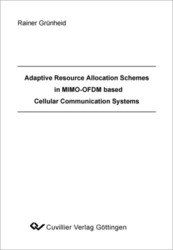| Departments | |
|---|---|
| Book Series (96) |
1378
|
| Nachhaltigkeit |
3
|
| Gesundheitswesen |
1
|
| Humanities |
2365
|
| Natural Sciences |
5406
|
| Engineering |
1793
|
| Engineering | 292 |
| Mechanical and process engineering | 862 |
| Electrical engineering | 686 |
| Mining and metallurgy | 30 |
| Architecture and civil engineering | 75 |
| Common |
98
|
|
Leitlinien Unfallchirurgie
5. Auflage bestellen |
|
Advanced Search
Adaptive Resource Allocation Schemes in MIMO-OFDM based Cellular Communication Systems (English shop)
Rainer Grünheid (Author)Preview
Table of Contents, Datei (7.4 KB)
Extract, Datei (85 KB)
In this thesis, novel concepts of an adaptive resource allocation in an OFDM-based cellular network are considered. The approach of self-organised beamforming and opportunistic scheduling (SOBOS) is investigated, where in each cell the resource assignment is carried out autonomously and independently on the basis of SINR measurements.
On the physical (PHY) layer, the use of multiple antennas (MIMO) is assumed. As an exten-sion of the original opportunistic beamforming approach, the self-organised beamforming principle is analysed, where well-defined grids of beams (GoBs) are applied to provide cover-age in the cellular network. This technique does not rely on any form of direct channel knowl-edge. Different methods for generating beams and composing the corresponding grids are taken into account. It is shown that by this beamforming technique, a good coverage of the network can be achieved. Using multiple beams in one GoB, the system goodput can be in-creased, leading to a hybrid TDMA/FDMA/SDMA scheme. The self-organised beamforming approach is shown to provide sufficient variations of the channel over time, frequency, and space, so that multiuser diversity can be exploited. The resources (time-frequency blocks) of the OFDM system can be assigned to users when their channel conditions are at their peak.
On top of beamforming, different scheduling algorithms are considered for adaptive resource allocation on the DLC layer. Following the approach of cross-layer design, the scheduler is fed with detailed information of the current channel state for each user and each resource. For that purpose, a measurement model is applied which takes all SINR values of the resource to derive a good estimate of the expected channel quality (Packet Error Rate). With the help of this estimate, resource allocation and PHY mode selection can be carried out. The perform-ance of the scheduling algorithms is compared, especially highlighting the trade-off between the different design goals of goodput maximisation and fairness.
Extending the idea of the cross-layer design between PHY and DLC layer, scheduling con-cepts which can actively control the use of beam grids are developed and analysed. Also, the use of certain QoS parameters is included. The options to adaptively use pre-defined as well as dedicated beams are proposed. It is shown that such adaptive measures are helpful for non-uniform user distributions and also to fulfil QoS requirements, i.e. by shaping dedicated beams to prioritised users.
Finally, some practical considerations are given in terms of appropriate signalling concepts, which are required to feed sufficient channel state information back to the base station in or-der to facilitate the use of adaptive resource allocation. It is shown that a good system per-formance can be maintained while the signalling overhead is kept at an acceptable level.
It appears from the analysed algorithms and techniques that the application of a self-organised beamforming, combined with opportunistic scheduling, is a promising new system concept to meet the demands of next generation’s mobile communication systems in terms of flexibility, adaptivity, and efficient use of resources.
| ISBN-13 (Printausgabe) | 386727410X |
| ISBN-13 (Hard Copy) | 9783867274104 |
| ISBN-13 (eBook) | 9783736924109 |
| Final Book Format | A5 |
| Language | English |
| Page Number | 174 |
| Edition | 1 |
| Volume | 0 |
| Publication Place | Göttingen |
| Publication Date | 2007-11-06 |
| General Categorization | Habilitation |
| Departments |
Electrical engineering
|
| Keywords | Adaptive Resource Allocation Schemes, MIMO-OFDM, Cellular Communication Systems. |








